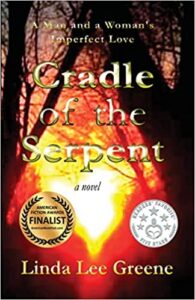THE WIND CHIME
May 10, 2021 | Author Friend Promo
by Linda Lee Greene, Author & Artist
 So often I think that if I keep my eyes closed, I can close out the ring of the wind chime that hangs just beyond my bedroom window from a corner beam of my patio roof. I can tell by the darkness beyond my shuttered eyelids that it is not yet dawn, possibly even the middle of the night. Like Tarzan the Rooster on my grandparent’s farm that proclaimed each rising morning when I was a youngster, this wind chime is pushy in its determination to heave me awake no matter the hour—for the reason, it seems, that it can no longer hold in its enthusiasm to have me embrace a new day. Call me nuts to ascribe human characteristics to an inanimate object, but it is nothing new in our history. In fact, the convoluted term for such a predilection is “anthropomorphism.” If nothing else, this time of isolation that is a condition of the coronavirus pandemic is likely to draw us into deeper contemplation than ever before—and in my reflections, anthropomorphism occupies me quite a lot in the configuration of one of my wind chimes. An inconvenient sidebar to my fascination with it is that it represents my most precious and yet challenging relationship.
So often I think that if I keep my eyes closed, I can close out the ring of the wind chime that hangs just beyond my bedroom window from a corner beam of my patio roof. I can tell by the darkness beyond my shuttered eyelids that it is not yet dawn, possibly even the middle of the night. Like Tarzan the Rooster on my grandparent’s farm that proclaimed each rising morning when I was a youngster, this wind chime is pushy in its determination to heave me awake no matter the hour—for the reason, it seems, that it can no longer hold in its enthusiasm to have me embrace a new day. Call me nuts to ascribe human characteristics to an inanimate object, but it is nothing new in our history. In fact, the convoluted term for such a predilection is “anthropomorphism.” If nothing else, this time of isolation that is a condition of the coronavirus pandemic is likely to draw us into deeper contemplation than ever before—and in my reflections, anthropomorphism occupies me quite a lot in the configuration of one of my wind chimes. An inconvenient sidebar to my fascination with it is that it represents my most precious and yet challenging relationship.
Apart from the fascinating history that wind chimes enjoy in chronicles of ancient Rome, China, India, and Japan with which evil eyes, malevolent spirits, and even pesky birds were warded off by wind chimes suspended from roofs of temples, pagodas, and homes, members of those cultures also turned to them to draw power and good luck to themselves. It occurs to me that there is another application of these delightful instruments of sound that is less considered, one that hides within the universe’s quirky ways of forcing us to face our most troublesome bumps on our road to nirvana.
The oldest of the three wind chimes in my possession was given to me by my mother not long before her death 28 years ago. It is pared-down and less impressive than the other two, modest is a better word for it—a thing appearing undiminished by ego, like my mother. Also like her, it speaks to me only when I speak to it—primarily in my thoughts. When she was alive, my mother never gave me advice about anything. Her retort whenever I solicited her advice was, “Why are you asking me? You’re smarter than I am!” That seems a wholly inadequate response to a daughter from her mother. As you can imagine, owing to this reason if no other, my mother is my Everest, the mountain I must climb to make it to nirvana. I am not a mountain climber, and for that reason, I understand that we will continue to travel together throughout time until we smooth the path of our shared journey.
Meanwhile, I find a measure of comfort in having arrived at some understanding of her. I see that the classic battle between the heart and mind of human beings found no ground whatsoever within my mother. Not that she didn’t have a fine mind—she was as smart as a tack. But my mother had an intuitive sense that “the center of man is not the mind but the heart. The New Testament [of the Bible] teaches that the heart is the main organ of psychic and spiritual life…”[1] The Bible’s Song of Songs 5:2 tells us, “I sleep; but my heart keeps watch.” That is my mother.
My mother also was wise to the fact that she served me best in allowing me to get acquainted with my own substance, to learn the lesson of bearing my own pain, on my own. She knew me better than I know myself.
I have always believed that my mother’s spirit lives in the wind chime she gave to me. It is the talisman she left behind for me. My mother’s death was a slow but a certain one, and although she didn’t say as much, I think she knew I would discover its secret—its secret that I would hear her in the voice of that little wind chime after she was gone—if only I would heed it.
 “2018 American Fiction Awards Cross-Genre Finalist” All #families have their secrets but some are much darker than others. Captivating psychological suspense in multi-award-winning author, Linda Lee Greene’s Cradle of the Serpent.
“2018 American Fiction Awards Cross-Genre Finalist” All #families have their secrets but some are much darker than others. Captivating psychological suspense in multi-award-winning author, Linda Lee Greene’s Cradle of the Serpent.
Greene weaves a tale that brims with unimaginable twists and turns in a long-term marriage. Enthralling journeys into the human psyche, romantic love, archaeology, and American Indian history carry the reader into archaeologist Lily Light’s quest to come to terms with the catastrophic consequences of her husband’s infidelity.
The trauma throws Lily into amazing episodes of past-life regression in which she takes on the persona of a young maiden named White Flower, a tribal member of the long-ago builders of Ohio’s Great Serpent Mound. White Flower’s life of thousands of years before reveals to Lily the unexpected path to her own salvation.
Lily Light is an archaeologist who works at the Great Serpent Mound in Ohio. Her work opened her to experiences, knowledge, and beliefs she never knew existed. Psychotherapist Michael Neeson is Lily’s therapist and guide in her dream travels.
AMAZON BUY LINK
 Multi-award-winning author and artist Linda Lee Greene describes her life as a telescope that when trained on her past reveals how each piece of it, whether good or bad or in-between, was necessary in the unfoldment of her fine art and literary paths.
Multi-award-winning author and artist Linda Lee Greene describes her life as a telescope that when trained on her past reveals how each piece of it, whether good or bad or in-between, was necessary in the unfoldment of her fine art and literary paths.
Greene moved from farm-girl to city-girl; dance instructor to wife, mother, and homemaker; divorcee to single-working-mom and adult-college-student; and interior designer to multi-award-winning artist and author, essayist, and blogger. It was decades of challenging life experiences and debilitating, chronic illness that gave birth to her dormant flair for art and writing. Greene was three days shy of her fifty-seventh birthday when her creative spirit took a hold of her.
She found her way to her lonely easel soon thereafter. Since then Greene has accepted commissions and displayed her artwork in shows and galleries in and around the USA. She is also a member of artist and writer associations.
Visit Linda on her blog and join her on Facebook.




